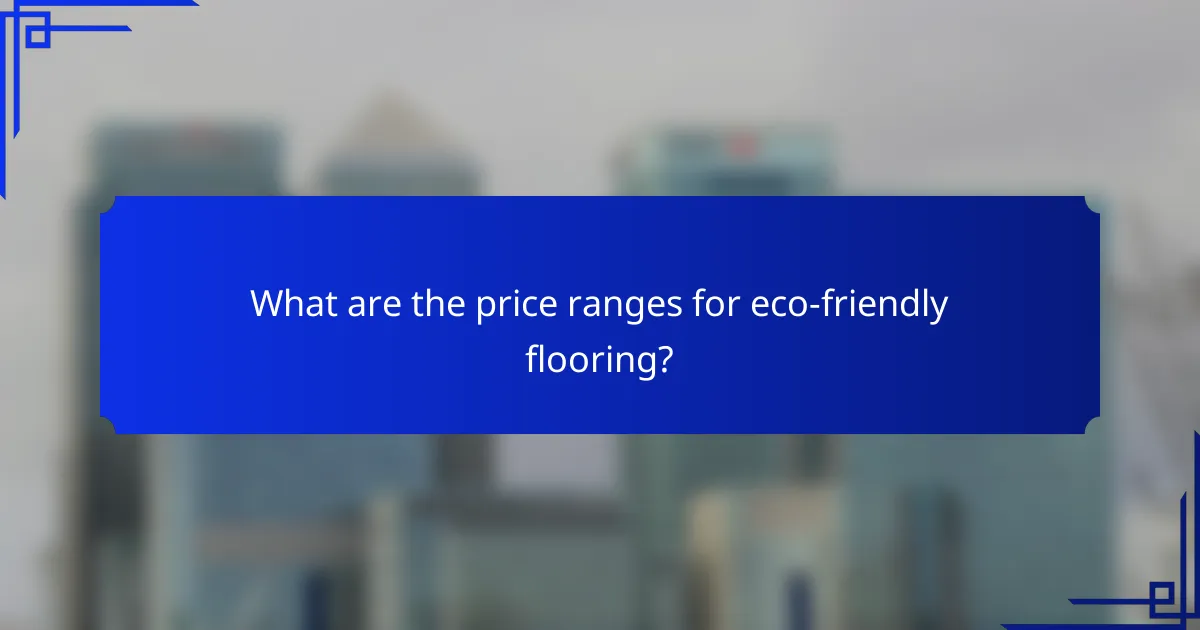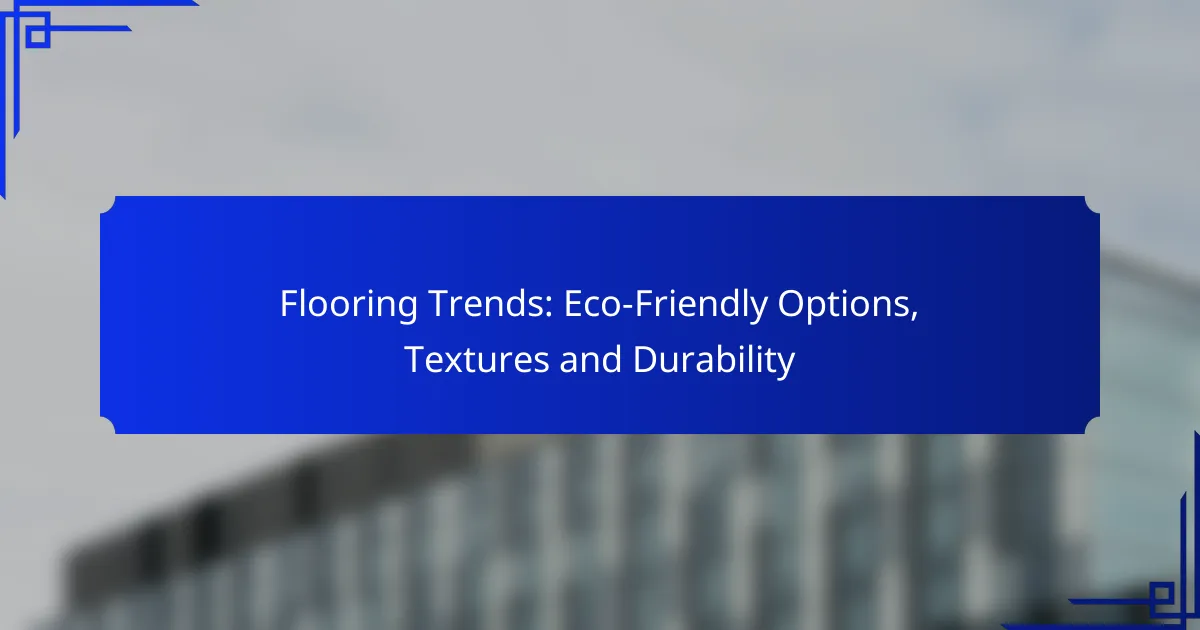As homeowners increasingly prioritize sustainability, eco-friendly flooring options such as bamboo, cork, and reclaimed wood are gaining popularity for their durability and minimal environmental impact. Additionally, the texture of flooring plays a crucial role in enhancing a space’s aesthetics and comfort, while also influencing maintenance needs. By understanding the durability ratings of various materials, consumers can make informed choices that balance style with longevity.

What are the top eco-friendly flooring options in the US?
The top eco-friendly flooring options in the US include bamboo, cork, reclaimed wood, linoleum, and rubber. These materials are sustainable, often made from renewable resources, and provide durability while minimizing environmental impact.
Bamboo flooring
Bamboo flooring is made from the fast-growing bamboo plant, making it a highly renewable resource. It is known for its strength and durability, often comparable to hardwood. When selecting bamboo, look for products that are certified by organizations like the Forest Stewardship Council (FSC) to ensure sustainable sourcing.
Installation can be done as a floating floor or glued down, and it typically costs between $3 to $8 per square foot. Regular maintenance involves sweeping and occasional mopping to keep it looking its best.
Cork flooring
Cork flooring is harvested from the bark of cork oak trees, which regenerate after harvesting, making it an eco-friendly choice. It offers excellent insulation, sound absorption, and is naturally resistant to mold and mildew. Cork flooring is available in various colors and patterns, allowing for creative designs.
The average cost ranges from $2 to $6 per square foot, and it can be installed as tiles or planks. To maintain cork flooring, avoid excessive moisture and use a damp mop for cleaning.
Reclaimed wood flooring
Reclaimed wood flooring is sourced from old buildings, barns, and other structures, giving new life to materials that would otherwise go to waste. This option adds character and uniqueness to a space, as each piece has its own history and appearance. It is also a sustainable choice, reducing the demand for new lumber.
Prices for reclaimed wood can vary significantly based on the type of wood and its condition, typically ranging from $5 to $15 per square foot. Ensure proper treatment and sealing to protect against wear and moisture.
Linoleum flooring
Linoleum flooring is made from natural materials like linseed oil, cork dust, and wood flour, making it biodegradable and eco-friendly. It is available in a wide range of colors and patterns, providing versatile design options. Linoleum is durable and can last for decades with proper care.
Installation costs generally fall between $2 to $5 per square foot. Regular cleaning with a damp mop and occasional waxing will help maintain its appearance and longevity.
Rubber flooring
Rubber flooring is made from recycled rubber, often sourced from tires, making it an excellent eco-friendly choice. It is highly durable, slip-resistant, and provides excellent cushioning, making it ideal for gyms, playrooms, and commercial spaces. Rubber flooring is available in tiles or rolls, offering flexibility in design.
The cost for rubber flooring typically ranges from $1 to $4 per square foot. To maintain rubber flooring, regular sweeping and occasional mopping with a mild detergent will keep it clean and functional.

How do textures impact flooring choices?
Textures significantly influence flooring choices by affecting aesthetics, comfort, and maintenance. The right texture can enhance a room’s ambiance while also determining how easy the flooring is to clean and how it feels underfoot.
Textured vinyl options
Textured vinyl flooring offers a variety of styles that mimic natural materials like wood or stone. These options are often more affordable and easier to maintain than their natural counterparts. Look for products with embossed surfaces that provide a realistic feel and improved slip resistance.
When selecting textured vinyl, consider the thickness and wear layer. A thicker vinyl can offer better durability, while a wear layer of at least 20 mils is recommended for high-traffic areas.
Natural wood grain finishes
Natural wood grain finishes provide a classic look that adds warmth and character to any space. These finishes can vary widely in appearance, from smooth to deeply textured, depending on the type of wood and the finishing process used. Popular choices include oak, maple, and walnut, each offering unique grain patterns.
When choosing wood grain finishes, consider the room’s humidity and temperature, as natural wood can expand and contract. Engineered wood may be a better option for areas with fluctuating conditions, as it is less prone to warping.
Matte vs. glossy surfaces
Matte and glossy surfaces each offer distinct advantages and drawbacks. Matte finishes tend to hide scratches and dirt better, making them ideal for high-traffic areas. They also create a more understated, modern look.
On the other hand, glossy surfaces can enhance light reflection, making spaces feel larger and brighter. However, they may require more frequent cleaning to maintain their appearance. Consider the specific needs of your space when deciding between matte and glossy options.

What are the durability ratings of popular flooring materials?
The durability ratings of flooring materials vary significantly based on their composition and intended use. Understanding these ratings helps in selecting the right flooring for different environments, balancing aesthetics with longevity.
Hardwood durability
Hardwood flooring is known for its strength and longevity, often lasting several decades with proper care. Its durability can be influenced by the type of wood; for example, oak and maple are generally more resilient than softer woods like pine.
To maintain hardwood’s durability, regular cleaning and refinishing every few years are recommended. Avoid excessive moisture, as it can lead to warping and damage.
Luxury vinyl durability
Luxury vinyl flooring offers impressive durability, typically rated for 10 to 20 years depending on the quality and thickness of the wear layer. It is resistant to scratches, dents, and moisture, making it suitable for high-traffic areas and homes with pets.
When selecting luxury vinyl, consider the thickness of the planks and the warranty offered, as these factors often correlate with durability. Regular cleaning with a damp mop can help maintain its appearance.
Ceramic tile durability
Ceramic tile is one of the most durable flooring options, often rated for a lifetime with proper installation. It is resistant to scratches, stains, and moisture, making it ideal for kitchens and bathrooms.
To ensure the longevity of ceramic tile, use appropriate grout and sealants, and avoid heavy impacts that can cause cracking. Regular cleaning with non-abrasive products will keep the tiles looking new.

How to choose the right flooring for your home?
Choosing the right flooring for your home involves assessing your lifestyle, the room’s function, and environmental factors. Consider durability, maintenance, and aesthetic appeal to ensure the flooring meets your needs and enhances your space.
Assessing traffic and usage
Understanding the traffic and usage of each room is crucial when selecting flooring. High-traffic areas, such as hallways and living rooms, require durable materials like hardwood, laminate, or tile that can withstand wear and tear.
For lower-traffic spaces, such as bedrooms or guest rooms, softer options like carpet or cork may be suitable. Always consider the activities that will take place in these areas to ensure the flooring can handle them effectively.
Evaluating moisture levels
Moisture levels significantly influence flooring choices, especially in areas like kitchens, bathrooms, and basements. For high-moisture environments, opt for water-resistant materials such as vinyl, tile, or treated hardwood to prevent damage and mold growth.
In contrast, spaces with low moisture levels can accommodate a wider range of flooring options. Always check for local humidity conditions and consider using moisture barriers where necessary to protect your flooring investment.
Considering maintenance requirements
Maintenance requirements vary widely among flooring types, impacting long-term satisfaction. For instance, hardwood floors may need periodic refinishing, while laminate and vinyl are generally easier to clean and maintain.
Evaluate how much time you are willing to dedicate to upkeep. If you prefer low-maintenance solutions, consider options like luxury vinyl tiles or sealed concrete, which require minimal care and are resistant to stains and scratches.

What are the price ranges for eco-friendly flooring?
Eco-friendly flooring options typically range from moderate to higher price points, depending on the material and quality. Generally, you can expect to pay anywhere from $3 to $10 per square foot for sustainable choices, with some premium products exceeding this range.
Bamboo flooring costs
Bamboo flooring is an increasingly popular eco-friendly choice, with prices generally ranging from $3 to $8 per square foot. The cost can vary based on the quality of the bamboo and the manufacturing process, with strand-woven bamboo often being more durable and slightly more expensive.
When considering bamboo flooring, look for products that are certified by the Forest Stewardship Council (FSC) to ensure sustainability. Installation costs may add an additional $1 to $5 per square foot, depending on your location and the complexity of the job.
Cork flooring costs
Cork flooring typically falls within the $4 to $10 per square foot range. This material is harvested from the bark of cork oak trees, making it a renewable resource. Prices can vary based on thickness, density, and whether the cork is pre-finished or requires finishing after installation.
Keep in mind that cork flooring is not only eco-friendly but also provides excellent insulation and sound absorption. Installation costs for cork can range from $1 to $4 per square foot, influenced by local labor rates and the existing floor condition.
